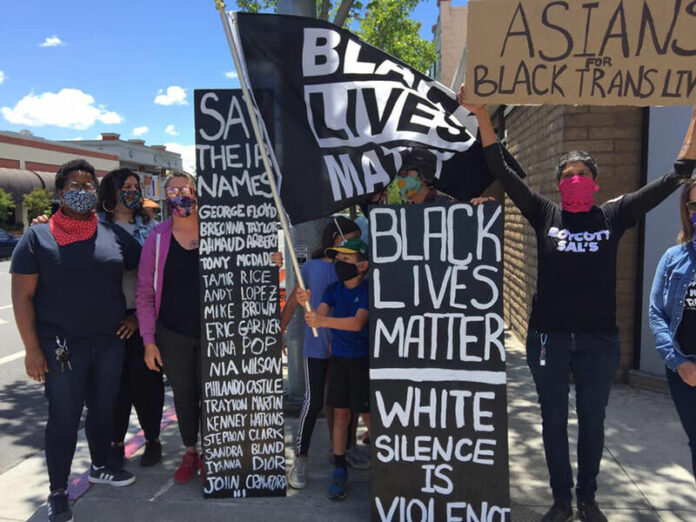Sunday, June 7, marked Sebastopol’s fourth day of protests over police brutality against people of color, and shouts of “No justice, no peace, no racist police” and the honking of horns filled the downtown area.
A contingent of around three dozen protesters, who had been staked out in front of the police station, marched to the corner of Main Street and Highway 12, joining other protesters and families holding signs. The protest had been advertised on Nextdoor as “family-friendly,” so there were a large number of children there with their parents.
Around 1 p.m., the protesters closed the intersection of Main Street and Highway 12 for eight minutes and 46 seconds — the length of time a Minneapolis police officer knelt on George Floyd’s neck before he died — before resuming their place on the sidewalk. The protest ran from noon to 2 p.m.
Holding police accountable and a focus on the role of whiteness
On Saturday, June 6, three dozen protesters lined the street running from Sebastopol’s downtown plaza to the Sebastopol Police Station, as demonstrations over the death of George Floyd at the hands of police in Minneapolis — and more broadly against police brutality against black Americans — continued for a third day in Sebastopol.
Organized by Kaelyn Ramsden, Shannon Creighton and Lillian Digden, this protest follows on the heels of a large protest in downtown Sebastopol on June 4 and a small, spontaneous gathering in the plaza on June 5.
“We realize that there was a protest the day before yesterday where one of the officers knelt with the protesters and that the police department actually has a Black Lives Matter poster in their window, and yet we’re here to ask them, ‘What is your plan of action as far as protecting the lives of black people in our community?’” said Ramsden. “‘Are you committing to a series of de-escalation trainings? Are you requiring that your police officers turn on their body cameras whenever they respond to police calls? Are you committing to a series of workshops for the police officers to really understand their internalized racial biases?’”
“We also want to have a consistent enough presence outside the police station so that the officers have an understanding that there are citizens in this town who will hold them accountable for their actions and who are paying really close attention to the treatment of all people of color, but especially black people in this community,” Ramsden said.
Creighton re-emphasized protesters’ role in keeping police accountable, but also said these protests are a part of a broader re-accounting of how and where we spend our money as a culture.
“I was also just having a conversation with a friend about local budgets and wanting to pay more attention to that and actually look at where the money is going to in our town in terms of the percentage spent on policing versus education or housing,” she said.
The question of what white people in a predominantly white town can and should do at this particular historical moment was also a central concern to the organizers.
Both Ramsden and Creighton said that this protest was organized in part in reaction to the way the women felt an earlier protest in southeast Santa Rosa in honor of Andy Lopez, the Latino teenager shot by Sheriff’s deputy Eric Gelhaus in 2013, had been taken over by a series of well-meaning, if tone-deaf white people eager to talk about their feelings.
“We were disappointed by how co-opted that was by white voices and particular, and how much time was taken up by them. I feel like it is absolutely important for white people to be speaking up about this issue, but if we haven’t started to really begin the work of dismantling white supremacy internally, if we pick up the mic and start speaking out loud to a crowd of predominantly people of color, we can actually do more harm than good,” Ramsden said.
Digden also said that today’s protest was in response to a call from SURJ, a national organization called Showing Up for Racial Justice.
“SURJ specifically organizes white folks show up in our communities to call other white people in as part of a multiracial majority for racial justice and it works with a lot of black-led or people-of-color-led organizations,” Digden said.
At today’s protest, all of the protestors stayed on the sidewalks and many of the drivers who passed honked their support. Protestors said they’d also been flipped off and had cars rev their engines menacingly while speeding in their direction. (While interviewing three high-school age protestors who were standing on the pedestrian median strip, this reporter witnessed a young white man in a pickup truck do just that.)
Creighton said she hopes this protest won’t be a one-time thing for the people involved or even for the people vocally supporting it as they drive by.
“The ultimate message that I hope people can leave with is that this is not a checking of the box, right? We can’t just show up to hold a sign to raise awareness — which is important — but it’s also about setting off, hopefully, a whole chain of events in our country and a chain of events within ourselves and in our communities” for racial justice and against police brutality. “That’s the message of this protest,” she said.
For more information about the issue of whiteness in black protest movements, see SURJ at showingupforracialjustice.org.
The second section of this article was published on June 6. It was updated on June 8.








